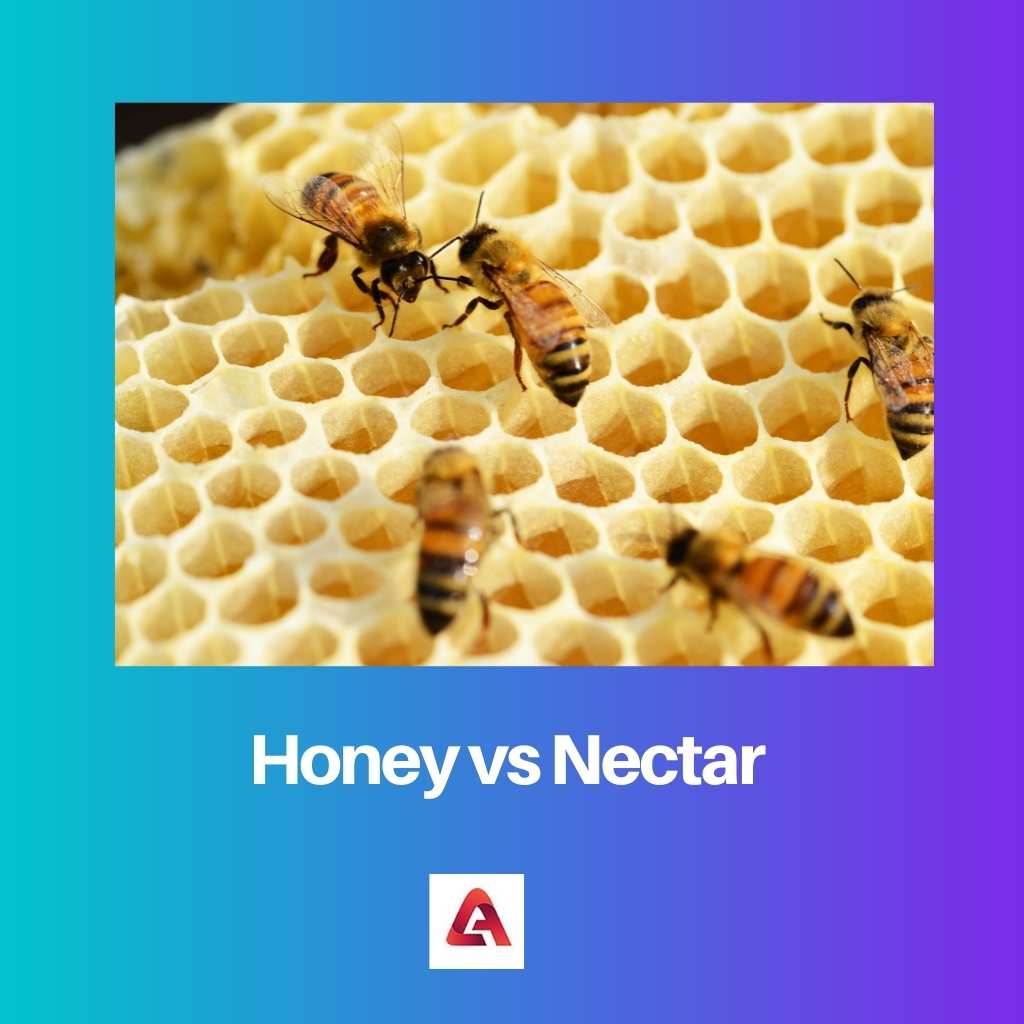Honey and nectar are both sweet food that is made by bees. Honey is secreted into special cells in the abdomen of honey bees called galleries or honeycombs.
Nectar is made in plants and trees and from other sources, including certain insects and even human beings.
Key Takeaways
- Honey is a sweet, viscous substance produced by bees from the nectar of flowers, while nectar is a sugary liquid produced by flowers to attract pollinators.
- Honey undergoes a process of regurgitation and evaporation by bees, resulting in a unique composition with antimicrobial properties.
- Nectar is primarily used as a source of energy for pollinators, while honey serves as a food source for bees during winter.
Honey vs Nectar
The difference between Honey and Nectar is that Honey is a viscous liquid secreted by bees from the glandular cells in their stomachs to feed their young ones, whereas, Nectar is what Honey bees drink and eat to live, which is stored in sacs inside their bodies.

Honey is fabricated by bees accumulating Nectar for utilizing as sugars consumed to hold up the metabolic activity of muscles, humans, honeybees, and other animals.
Bees utilize the ingested Nectar as food energy for flight or heating in cold weather. The diversity of Honey fabricated around the world returns to the multiple pollination systems that occur in nature.
Nectar is a natural sugar-based liquid that plants magnificently fabricate to help them to reproduce. It can also be well-known as “nectar” or “flower nectar.”
It is made up of potassium, phosphoric acid, glucose, sucrose, and numerous other organic compounds.
Comparison Table
| Parameters of Comparison | Honey | Nectar |
|---|---|---|
| Definition | Honey is a sweet, sticky liquid that bees make from the secretions of plant pollen and nectar. | Nectar is the liquid that plants produce to attract pollinators like insects and hummingbirds. |
| Element | It is comprised of antibacterial and antifungal. | It is not comprised of antibacterial and antifungal. |
| Intoxicants | Honey has a high ethyl alcohol content. | Nectar has no ethyl alcohol at all. |
| Fabrication | To fabricate honey, the bees need to visit hundreds of flowers. | Nectar is the food source for bees during the spring and summer months. |
| Conserve | It does not contain citric acid and lemon to preserve the liquid. | It contains citric acid and lemon to preserve the liquid. |
What is Honey?
Honey is the stimulant that honeybees fabricate as they eat nectar and transform it into honey. The tints of honey range from golden yellow to dark brown, counting on the flowers the bees feed on.
Honey can be established in many places around the world, but it is mostly congregated by beekeepers who try to avoid disturbing the hives.
Honeybees pollinate more than 130 different crops around the world, including various vegetables and fruits. This includes apples, cherries, blueberries, cacao beans, cacti, coffee beans, currants, figs, and grapes.
Honey is fabricated when the nectar is mixed with enzymes and other ingredients inside a bee’s stomach, which turns it into a thick liquid. Then, to eliminate any contamination, the bee regurgitates and spits it right back out.
The bees then stick their tongues onto the inside of the beehive and blow-dry the honey to ensure it doesn’t ferment, ruining the flavour and making it unsafe to eat. Honey is crowded with sustenances such as vitamins B1, B2, C, D, and E.
Honey is frequently utilized as a sweetener in many dishes around the globe. It is fabricated by bees and assembled from nectar or the excretion of plants.
It possesses an attribute flavour due to a certain mixture of monosaccharides that braces sweet taste reception when eating compared with artificial sugars such as high-fructose corn syrup.
Honey utilization and production have an extended history as an ancient activity.

What is Nectar?
Nectar is a popular drink because it is made of natural ingredients that are derived from honey or fruit juice, which contains electrolytes. Electrolytes are very important to the body.
They help transport nutrients from one place to another as well as other important functions. Diet versions of Nectars contain artificial sweeteners, such as saccharin or sorbitol, instead of sugar.
Nectar is a sugary liquid secreted by many flowering plants. While some nectars are palatable to humans, most serve as food for nectar-consuming animals and insects such as butterflies, bees, and bats.
In most cases, this sugary liquid is secreted from a part of the flower that is not the stigma, the female part of a flower that grows at the end of a stalk called a style. These nectars are found on the underside of the petals.
A segmented sac-like structure produces the nectar called a receptacle which hangs underneath the spathe. Sometimes each side of the receptacle may be filled with nectar-producing glands.
Receptacles are found on different parts of a plant, such as on or around leaves and stems.

Main Differences Between Honey and Nectar
- The Honey fabrication encompasses visiting numerous flowers, whereas Nectar is fabricated in the glands of plants and trees.
- Honey does not act as a natural pesticide, whereas Nectar acts as a natural pesticide that assists in protecting the flower from being eaten by insects or animal prey.
- Bees and other nectar-feeding insects construct honey, whereas Nectar is a kind of liquid that flows freely and is constructed by flowers.
- The intoxicants in Honey are high, whereas the intoxicants in Nectar are low.
- The elements in Honey encompass antibacterial and antifungal, whereas the elements in Nectar lack antibacterial and antifungal.

References
- https://link.springer.com/article/10.1007/BF01055368
- https://www.sciencedirect.com/science/article/pii/S0308814604004625
- https://www.tandfonline.com/doi/abs/10.1080/87559129909541199
